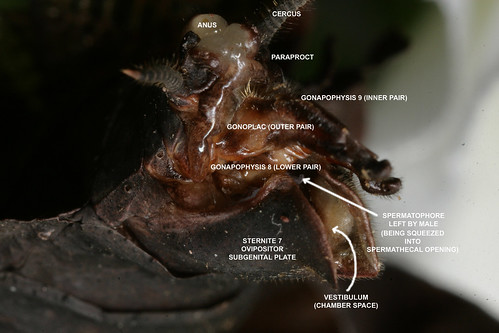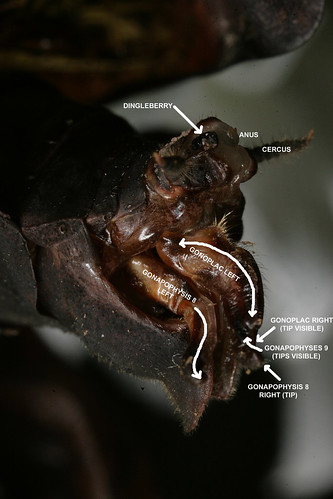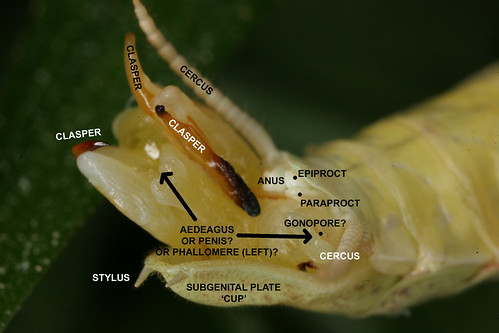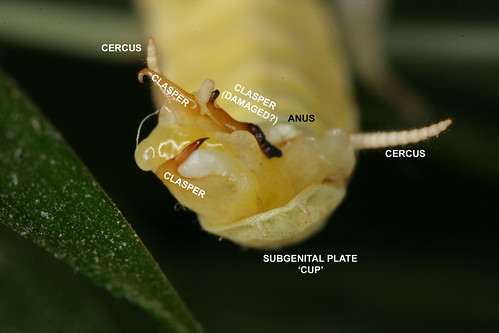MantidLord
Well-known member
Hey guys, I was wondering if there are any of you who could provide me with the reproductive parts of mantids. Also, if you know the organs too, then please don't be shy. Thanks.

Thanks a lot Kamakiri. That's very helpful. Thought this thread was just gonna slip into the shadows for a minute.I can only help with terms I think I know...Female:
Cerci
Gonapophyses - Valves or Valvulae or Valvifers
Gonoplac
Oviduct
Ovipositor - Subgenital plate
Ovaries
Spermatheca
Male:
Claspers
Subgenital plate - 'Cup'
...hope that helps kick-off your research.
No problemo. I was posting pictures of the valves gyrating out of the ovipositor and I thought these might help visualize:Thanks a lot Kamakiri. That's very helpful. Thought this thread was just gonna slip into the shadows for a minute.










Very cool, Kamakiri! The only thing that I would add is that the dissogenous deviation of the disparate dingleberry is the oohlala.No problemo. I was posting pictures of the valves gyrating out of the ovipositor and I thought these might help visualize:Bigger pic

Bigger pic

YES!!! You're awesome!No problemo. I was posting pictures of the valves gyrating out of the ovipositor and I thought these might help visualize:Bigger pic

Bigger pic

Not of a ghost. There was one of my limbata males that had everything hanging out after his first time mating. There were three of what I think are the three asymmetrical claspers and the anus visible and identifiable by me. I'll try to dig it up and label it best I can. It also doesn't help that in my recollection, there aren't as many diagrams of the male reproductive insect parts in general, let alone mantises. And to make matters worse, the males usually 'put everything away' once their done. So there's less opportunity to photograph.Got a pic like that of the male?
Any species will work.Not of a ghost. There was one of my limbata males that had everything hanging out after his first time mating. There were three of what I think are the three asymmetrical claspers and the anus visible and identifiable by me. I'll try to dig it up and label it best I can. It also doesn't help that in my recollection, there aren't as many diagrams of the male reproductive insect parts in general, let alone mantises. And to make matters worse, the males usually 'put everything away' once their done. So there's less opportunity to photograph.Phil- :lol:
MantidLord - Glad to helpLemme know if you want me to post the version without the 'dingleberry' note. :lol:
Kamakiri: No, lol those pics and diagrams are perfect, thanks.Kamakiri: I looked at yr pic and its labeling more closely, and I've got say that even with my limited knowledge of a female mantid's naughty bits, I am seriously impressed.Mantidlord: You don't really think that you are going to get off this easily, do you? I'm as sure as I can be that Kamakiri got all the bits labelled correctly, but no picture like this can or is intended to give you much insight into female insect genitalia. If yr HS textbook doesn't have any good pics (and often, they don't), Google, <insect genitalia orthoptera> . You aren't going to find a pic/diagram of a mantis, but you will find a grasshopper or cockroach, which is close enough for government work. Learn why Kamakiri used the numbers 8 and 9 in his labeling, and find out how these bits act as valves. You also need to check out the third valve, the gonostyle.
Good luck! We shall be giving you a test!


Amazing. Great detail. And I'm definitely gonna research the parts.Male parts:Bigger pic

Bigger pic

As requested
But I should note, that I have several questions on what is really what in those labels. It is possible that each clasper as I've labelled is a phallomere, or the whole stem with the 3 claspers may be one phallomere. Also not sure where the gonopore is, or if it is at the tip of what may be a pseudo-*****. I have more reading and research to do.
Some while ago (time flies for old farts) a good friend of mine, in her second year at uni, told me how glad she was to be doing vertebrate anatomy after the "yellow goo" that is the subject of first year, invertebrate anatomy. It's true, and it is hard to distinguish one bit of goo from another and extraordinarily hard to photograph.Male parts, as requestedBut I should note, that I have several questions on what is really what in those labels. It is possible that each clasper as I've labelled is a phallomere, or the whole stem with the 3 claspers may be one phallomere. Also not sure where the gonopore is, or if it is at the tip of what may be a pseudo-*****. I have more reading and research to do.
Yes.There have been some exceptionally good threads on the forum lately. This is certainly on of them.
Enter your email address to join: